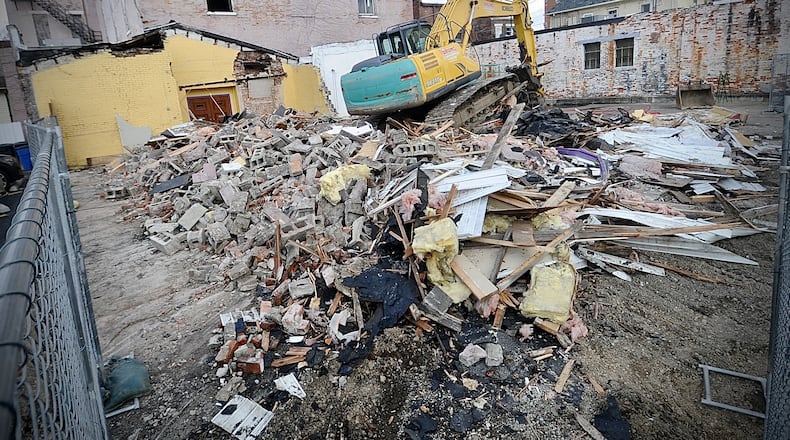Demolition of the rear portion of the Tavern building began very early Wednesday morning. Historic preservation advocates tried to stop it, and at around 9 a.m., Wall issued a court order stopping demolition of the rear portion. The city issued a stop-work order while city Law Director Grant Kerber filed for court intervention, arguing the owner was required to have a certificate of appropriateness through the city before removal. None had been sought.
Derek Muncy, lawyer for Randy Kimmel of 116 West Main LLC, said Wednesday they were following the order that the county Building Department had issued Monday. That order called for abatement within 14 days because the property posed an imminent danger and was a safety hazard.
“It speaks for itself. We are doing our best to comply with those orders,” Muncy said.
But the county building department said Wednesday that its order did not override other orders. The county order included options for abatement that included repairs, as well as building removal.
“The Building Department’s order does not prescribe which option the owners must take, nor does the order supersede any other administrative or legal actions taken by the courts or the city of Troy,” Richard Osgood, county development director, wrote. “The order simply requires the situation to be remedied, and all options outlined in the order must meet the legal requirements set forth by the city of Troy and any other permitting agencies.
Wall heard from Rob England, county chief building official, during the Wednesday afternoon hearing. He was asked if, in his opinion, the building presented an imminent danger of collapse after the demolition that took place already. He told Wall he “would have to defer that (answer) to a structural engineer.”
Wall heard comments during the hearing about damage that occurred to the vacant building during high winds the past week. Damage described included a piece of roof blowing off the rear building that was demolished Wednesday morning and damage to a south wall where a broken header was noted above a door with sagging and falling bricks. Wall asked if a header could be shored up. England said he had seen that type of repair at other buildings.
Early Wednesday morning, Troy Historic Preservation Alliance member Ben Sutherly briefly stood between large machinery and a portion of the structure it was trying to remove. When he arrived shortly after 7 a.m., “They were actively bulldozing,” Sutherly said. “I stepped between the bulldozer and the building. There is a legal process to be followed, and it needs to play out.”
Jeremy Tomb, an attorney whose offices are next to the building, said cameras at his building showed workers on site around 3 a.m.
The building was damaged in the January 2020 tornado that moved through a portion of Troy. The sidewalk and parking in front of the structure has been fenced off for more than three years since then.
The city planning commission and Board of Zoning Appeals originally approved a demolition permit for the structure, but their decisions were overturned last fall by Wall. The 2nd District Court of Appeals last week upheld that ruling.
Wall also filed an order Wednesday for a show-cause hearing Friday on a contempt count against 116 West Main LLC. In the notice, Wall said that a stay on demolition that had been approved by the court earlier was still in effect when demolition began Wednesday morning.
The Tavern building lies within the city historic district but is not listed on historical records. Those fighting to save the structure contend, however, that is of significance for several reasons ,including housing an early county Courthouse.
That Courthouse was where every person of color had to go to register his or her intent to remain in the county until laws requiring the registration were repealed in 1849. Among those registering were former slaves known as the Randolph Freed People who settled near Piqua in the late 1840s.
The building is located on the south side of Main Street just a block west of the Troy Public Square and near the county government complex of the historic 1880s Courthouse and the adjacent county Safety Building.
The buildings next to the Tavern structure on the south side of the street house a local history room, jewelry store, law offices and a bar.
Across Main Street, the former Masonic Building has been undergoing renovations for reuse, including as the home of new businesses on the first floor.
The street itself on Main Street is undergoing a multimillion-dollar reconstruction and streetscape project, with some of that work now in the area of the building.
About the Author




